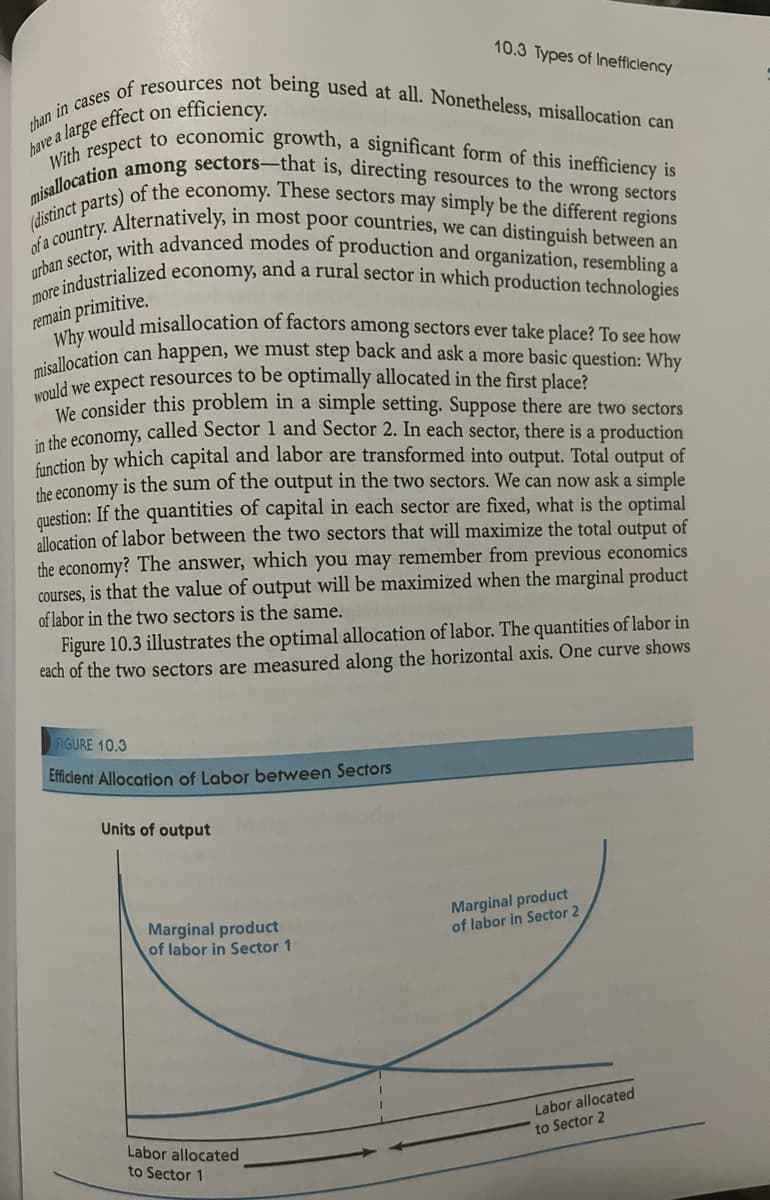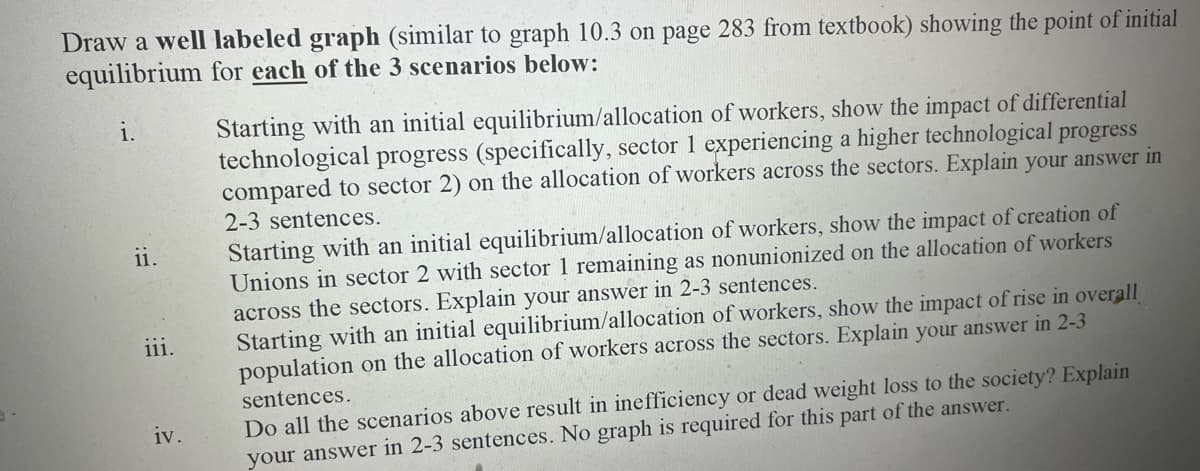Draw a well labeled graph (similar to graph 10.3 on page 283 from textbook) showing the point of initial equilibrium for each of the 3 scenarios below: i. 11. Starting with an initial equilibrium/allocation of workers, show the impact of differential technological progress (specifically, sector 1 experiencing a higher technological progress compared to sector 2) on the allocation of workers across the sectors. Explain your answer in 2-3 sentences. Starting with an initial equilibrium/allocation of workers, show the impact of creation of Unions in sector 2 with sector 1 remaining as nonunionized on the allocation of workers across the sectors. Explain your answer in 2-3 sentences. uilibrium/allocation of workers, show the impact of rise in overall or in 2-3
Draw a well labeled graph (similar to graph 10.3 on page 283 from textbook) showing the point of initial equilibrium for each of the 3 scenarios below: i. 11. Starting with an initial equilibrium/allocation of workers, show the impact of differential technological progress (specifically, sector 1 experiencing a higher technological progress compared to sector 2) on the allocation of workers across the sectors. Explain your answer in 2-3 sentences. Starting with an initial equilibrium/allocation of workers, show the impact of creation of Unions in sector 2 with sector 1 remaining as nonunionized on the allocation of workers across the sectors. Explain your answer in 2-3 sentences. uilibrium/allocation of workers, show the impact of rise in overall or in 2-3
Chapter20: Economic Growth In The Global Economy
Section: Chapter Questions
Problem 5P
Related questions
Question
Only question 1 and 2

Transcribed Image Text:than in cases of resources not being used at all. Nonetheless, misallocation can
have a large effect on efficiency.
With respect to economic growth, a significant form of this inefficiency is
misallocation among sectors-that is, directing resources to the wrong sectors
(distinct parts) of the economy. These sectors may simply be the different regions
Alternatively, in most poor countries, we can distinguish between an
of a country..
urban sector, with advanced modes of production and organization, resembling a
more industrialized economy, and a rural sector in which production technologies
remain primitive.
Why would misallocation of factors among sectors ever take place? To see how
misallocation can happen, we must step back and ask a more basic question: Why
would we expect resources to be optimally allocated in the first place?
We consider this problem in a simple setting. Suppose there are two sectors
in the economy, called Sector 1 and Sector 2. In each sector, there is a production
function by which capital and labor are transformed into output. Total output of
the economy is the sum of the output in the two sectors. We can now ask a simple
question: If the quantities of capital in each sector are fixed, what is the optimal
allocation of labor between the two sectors that will maximize the total output of
the economy? The answer, which you may remember from previous economics
courses, is that the value of output will be maximized when the marginal product
of labor in the two sectors is the same.
Figure 10.3 illustrates the optimal allocation of labor. The quantities of labor in
each of the two sectors are measured along the horizontal axis. One curve shows
FIGURE 10.3
Efficient Allocation of Labor between Sectors
Units of output
10.3 Types of Inefficiency
Marginal product
of labor in Sector 1
Labor allocated
to Sector 1
Marginal product
of labor in Sector 2
Labor allocated
to Sector 2

Transcribed Image Text:3
Draw a well labeled graph (similar to graph 10.3 on page 283 from textbook) showing the point of initial
equilibrium for each of the 3 scenarios below:
1.
ii.
111.
iv.
Starting with an initial equilibrium/allocation of workers, show the impact of differential
technological progress (specifically, sector 1 experiencing a higher technological progress
compared to sector 2) on the allocation of workers across the sectors. Explain your answer in
2-3 sentences.
Starting with an initial equilibrium/allocation of workers, show the impact of creation of
Unions in sector 2 with sector 1 remaining as nonunionized on the allocation of workers
across the sectors. Explain your answer in 2-3 sentences.
Starting with an initial equilibrium/allocation of workers, show the impact of rise in overall
population on the allocation of workers across the sectors. Explain your answer in 2-3
sentences.
Do all the scenarios above result in inefficiency or dead weight loss to the society? Explain
your answer in 2-3 sentences. No graph is required for this part of the answer.
Expert Solution
This question has been solved!
Explore an expertly crafted, step-by-step solution for a thorough understanding of key concepts.
Step by step
Solved in 2 steps with 2 images

Knowledge Booster
Learn more about
Need a deep-dive on the concept behind this application? Look no further. Learn more about this topic, economics and related others by exploring similar questions and additional content below.Recommended textbooks for you

Exploring Economics
Economics
ISBN:
9781544336329
Author:
Robert L. Sexton
Publisher:
SAGE Publications, Inc

Principles of Economics 2e
Economics
ISBN:
9781947172364
Author:
Steven A. Greenlaw; David Shapiro
Publisher:
OpenStax

Brief Principles of Macroeconomics (MindTap Cours…
Economics
ISBN:
9781337091985
Author:
N. Gregory Mankiw
Publisher:
Cengage Learning

Exploring Economics
Economics
ISBN:
9781544336329
Author:
Robert L. Sexton
Publisher:
SAGE Publications, Inc

Principles of Economics 2e
Economics
ISBN:
9781947172364
Author:
Steven A. Greenlaw; David Shapiro
Publisher:
OpenStax

Brief Principles of Macroeconomics (MindTap Cours…
Economics
ISBN:
9781337091985
Author:
N. Gregory Mankiw
Publisher:
Cengage Learning

Essentials of Economics (MindTap Course List)
Economics
ISBN:
9781337091992
Author:
N. Gregory Mankiw
Publisher:
Cengage Learning